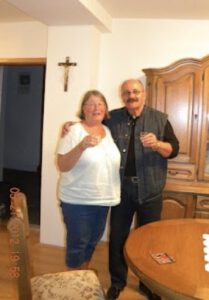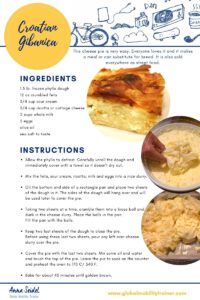My parents had very different childhoods. My dad grew up as a Third Culture Kid, travelling the world. My mom grew up in the wilds of Oregon, the oldest daughter of a forest ranger. She radically changed her life’s trajectory when she went abroad on a university exchange to Croatia in 1970.
By the time they met they both had a deep seated curiosity about the world and all its colourful facets and flavours – a curiosity that drove us to Germany and beyond in the years that followed.
In the following post my mom shares some memories of her experiences as a young woman in Croatia, living in a dorm in Zagreb, spending weekends in the countryside, learning to integrate and adapt and embrace a new culture wholeheartedly. Growing up and coming of age a long way from home. And she includes a recipe for delicious Gibanica, a Balkan cheese pie speciality, for us to try.
Living in a new culture
I had a nice memory today and it set me right off to baking! Memories of living in Zagreb (former Yugoslavia, now Croatia) as a young college student and my first experience living in a foreign country. I was enthusiastic about the whole experience and absorbed each new discovery with joy.
It was all new and so very different and I was determined to immerse myself into the language and culture. Distancing myself from the other American students and aligning myself with as many Yugoslav friends as I could. I moved into a local student dorm as an illegal resident, sharing a 3 bed-room with 3 friends where I kept my things in a suitcase under the bed and slept with my friend Kaja.
Dorm Life, Croatia 1970
 Dorm life was quite different. We were not allowed to cook in our rooms but of course we did anyway. One special treat was to take fresh bread, smear it all over with garlic and oil and “roast” it on our illegal heater. There were very different rules to follow. We were required to wax and polish our hardwood floor once a month. Each room was issued a can of paste wax and a brush. We rubbed the wax into the floor and wore felt slippers to polish it to a shine. There were inspections afterwards and sometimes it would have to be done all over again. Also once a month we were given new blankets and sheets. The blankets had little feet printed on one end – that part went on the foot of the bed.
Dorm life was quite different. We were not allowed to cook in our rooms but of course we did anyway. One special treat was to take fresh bread, smear it all over with garlic and oil and “roast” it on our illegal heater. There were very different rules to follow. We were required to wax and polish our hardwood floor once a month. Each room was issued a can of paste wax and a brush. We rubbed the wax into the floor and wore felt slippers to polish it to a shine. There were inspections afterwards and sometimes it would have to be done all over again. Also once a month we were given new blankets and sheets. The blankets had little feet printed on one end – that part went on the foot of the bed.
We had hot water twice a week for showering. Of course there was a long line waiting for your turn. In our room we had hooks on the wall for our towels. And everyone had two towels. One hook was about eye level and another waist high. You used the upper towel to dry the upper half of your body and the other for your lower, presumably stinkier half.
The laundry room was equipped with several hotplates and large pans. You placed your dirty clothes in a pan, filled it with water and detergent and set it to boil. After it boiled, you stirred it for a while then rinsed everything. There were clothes lines on the large porches at each end of our floor to hang the clothes to dry. In the winter the clothes got stiff as a board but we merely brought them in to thaw.
We had outdoor clothes and inside clothes. As soon as you came in from outside, you changed clothes. Your outside outfit was hung in the window to “air” and you donned a robe or housedress for the time in the room. One never wore shoes in the room. At the entrance to our room was a shoe rack where your shoes were exchanged for indoor slippers.
All of these things and many others were very foreign to me. My friends thought I was a bit ignorant sometimes but with time I got used to it all.
Comfort food and village life
I drank many tiny cups of Turkish coffee with my friends and loved strolling the streets in the evenings arm and arm with my friend Kaja. The best times were weekend trips to Kaja’s village. Her mother was a seamstress and she made several dresses for me. I loved the home-cooked food! The main meal always started with soup. Kaja’s mom would go out to the yard, catch a chicken and cook it up. The soup made from the chicken was like nothing I’d ever had before. Well-cleaned feet were cooked in the soup too and imparted a wonderful flavor. Kaja had 2 sisters and they always flipped a coin to see who got the feet. It was a favorite of theirs and often offered to me but that was one thing I never tried.
The memory I had today was of watching Kaja’s mother prepare pie dough. This dough is made of only flour and water and is similar to Phyllo dough. She mixed and kneaded and rolled it out until it was quite thin. Then she started stretching it until it hung down the sides of the table almost to the floor. This was a fascinating process that I’ve never been able to duplicate (I buy my Phyllo dough at the grocery store). The very thin dough was then cut into large squares and wrapped in parchment paper. Not only was this used for making wonderful Baklava, it was used for pies too – meat pies, vegetable pies and cheese pies. My favorite was something called Gibanica. And remembering this set me to baking!
Peggy's advice for adaptation
 My belief is that the only way to really experience a new culture is to jump in and try everything (except maybe chicken feet). If you stay in your little bubble, you will miss out on so many special things. After I got proficient in the language, it was a challenge to see how long I could “pass” as a local. Inevitably i would slip up in a false gesture or wrong use of a idiom and someone would say “where are you from anyway?”
My belief is that the only way to really experience a new culture is to jump in and try everything (except maybe chicken feet). If you stay in your little bubble, you will miss out on so many special things. After I got proficient in the language, it was a challenge to see how long I could “pass” as a local. Inevitably i would slip up in a false gesture or wrong use of a idiom and someone would say “where are you from anyway?”
I loved learning how things were done in every country I’ve lived in and encourage others to do this too. It is very enriching and broadens your horizon forever. It is especially nice to take some of those new cultural ideas back home with you.
Well, my Gibanica is nearly done. I shall cut a nice big slice and sit back an reminisce a bit. Photo in Yugoslavia, 2012 with Kaja’s husband, Drago.





